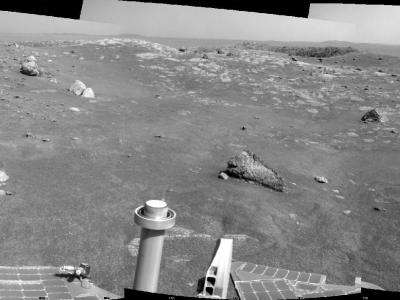NASA spacecraft provides travel tips for Mars rover

(PhysOrg.com) -- NASA's Mars Opportunity rover is getting important tips from an orbiting spacecraft as it explores areas that might hold clues about past Martian environments.
Researchers are using a mineral-mapping instrument aboard NASA's Mars Reconnaissance Orbiter to help the rover investigate a large ancient crater called Endeavour. The orbiter's Compact Reconnaissance Imaging Spectrometer for Mars (CRISM) is providing maps of minerals at Endeavour's rim that are helping the team choose which area to explore first and where to go from there. As Mars Reconnaissance Orbiter orbits more than 241 kilometers high (150 miles), the CRISM instrument provides mapping information for mineral exposures on the surface as small as a tennis court.
"This is the first time mineral detections from orbit are being used in tactical decisions about where to drive on Mars," said Ray Arvidson of Washington University in St. Louis. Arvidson is the deputy principal investigator for the Spirit and Opportunity rovers and a co-investigator for CRISM.
Opportunity's science team chose to begin driving the rover toward the 22.5-kilometer-wide (14-mile-wide) crater in 2008, after four years studying other sites in what initially was planned as a three-month mission. The rover has traveled approximately nine miles since setting out for Endeavour crater. It will take several months to reach it.
The team plans for Opportunity's exploration of Endeavour to begin at a rim fragment called Cape York. That feature is too low to be visible by the rover, but appears from orbit to be nearly surrounded by water-bearing minerals. The planned route then turns southward toward a higher rim fragment called Cape Tribulation, where CRISM has detected a class of clay minerals not investigated yet by a ground mission. Spacecraft orbiting Mars found these minerals to be widespread on the planet. The presence of clay minerals at Endeavour suggests an earlier and milder wet environment than the very acidic, wet one indicated by previous evidence found by Opportunity.
"We used to have a disconnect between the scale of identifying minerals from orbit and what missions on the surface could examine," said CRISM team member Janice Bishop of NASA's Ames Research Center in Moffett Field, Calif., and the SETI Institute of Mountain View, Calif. "Now, rovers are driving farther and orbital footprints are getting smaller."
Ten years ago, an imaging spectrometer on NASA's Mars Global Surveyor orbiter found an Oklahoma-sized area with a type of the mineral hematite exposed. This discovery motivated selection of the area as Opportunity's 2004 landing site. Each pixel footprint for that spectrometer was 3.2 kilometers (2 miles) across. CRISM resolves areas about 18 meters (60 feet) across. Last fall, the instrument began using a pixel-overlap technique that provided even better resolution.
Opportunity has just reached a 90-meter-diameter crater (300-foot) called Santa Maria, where CRISM detected a patch of ground with indications of water bound into the mineral. Opportunity will conduct a science campaign at the crater for the next several weeks to compare the ground results to the orbital indications.
"Opportunity has driven farther in the past Martian year than in any previous one," said John Callas, Mars Exploration Rover project manager at NASA's Jet Propulsion Laboratory, Pasadena, Calif.
A Martian year lasts approximately 23 months. During the past Martian year, Opportunity covered more than 12 kilometers (7.5 miles) of the mission's 26 total kilometers (16 miles) traveled since it landed in January 2004. The rover has returned more than 141,000 images.
Mars Reconnaissance Orbiter reached the Red Planet in 2006 to begin a two-year primary science mission. Its data show Mars had diverse wet environments at many locations for differing durations during the planet's history, and climate-change cycles persist into the present era. The mission has returned more planetary data than all other Mars missions combined.
Provided by JPL/NASA





















